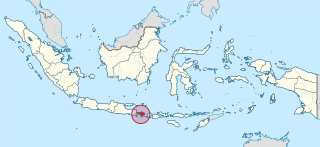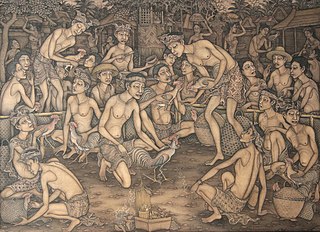Related Research Articles

Bali is a province of Indonesia and the westernmost of the Lesser Sunda Islands and the easternmost of the Sunda Shelf. East of Java and west of Lombok, the province includes the island of Bali and a few smaller offshore islands, notably Nusa Penida, Nusa Lembongan, and Nusa Ceningan to the southeast. The provincial capital, Denpasar, is the most populous city in the Lesser Sunda Islands and the second-largest, after Makassar, in Eastern Indonesia. The upland town of Ubud in Greater Denpasar is considered Bali's cultural centre. The province is Indonesia's main tourist destination, with a significant rise in tourism since the 1980s. Tourism-related business makes up 80% of its economy.
The island of Bali has a system of social organization similar to the Indian caste system.

The culture of Indonesia has been shaped by long interaction between original indigenous customs and multiple foreign influences. Indonesia is centrally-located along ancient trading routes between the Far East, South Asia and the Middle East, resulting in many cultural practices being strongly influenced by a multitude of religions, including Buddhism, Christianity, Confucianism, Hinduism, and Islam, all strong in the major trading cities. The result is a complex cultural mixture, often different from the original indigenous cultures.

The Balinese people are an Austronesian ethnic group native to the Indonesian island of Bali. The Balinese population of 4.2 million live mostly on the island of Bali, making up 89% of the island's population. There are also significant populations on the island of Lombok and in the easternmost regions of Java.

Hinduism in Indonesia, as of the 2018 census, is practised by about 1.74% of the total population, and almost 87% of the population in Bali. Hinduism was the dominant religion in the country before the arrival of Islam and is one of the six official religions of Indonesia today. Hinduism came to Indonesia in the 1st-century through Indian traders, sailors, scholars and priests. A syncretic fusion of pre-existing Javanese folk religion, culture and Hindu ideas, that from the 6th-century also synthesized Buddhist ideas as well, evolved as the Indonesian version of Hinduism. These ideas continued to develop during the Srivijaya and Majapahit empires. About 1400 CE, these kingdoms were introduced to Islam from coast-based Muslim traders, and thereafter Hinduism, which was previously the dominant religion in the region, mostly vanished from many of the islands of Indonesia.

Balinese art is art of Hindu-Javanese origin that grew from the work of artisans of the Majapahit Kingdom, with their expansion to Bali in the late 14th century. From the sixteenth until the twentieth centuries, the village of Kamasan, Klungkung, was the centre of classical Balinese art. During the first part of the twentieth century, new varieties of Balinese art developed. Since the late twentieth century, Ubud and its neighboring villages established a reputation as the center of Balinese art.

Museum Rudana or Rudana Art Museum is an art museum in Peliatan, Gianyar Regency, Bali, Indonesia. It was built by Nyoman Rudana, following the concept of the Bali humanist philosophy of Tri Hita Karana, where art makes a contribution to public wellbeing.

The Klungkung Palace, officially Puri Agung Semarapura, is a historical building complex situated in Semarapura, the capital of the Klungkung Regency (kabupaten) on Bali, Indonesia. The palace (puri) was erected at the end of the 17th century, but largely destroyed during the Dutch colonial conquest in 1908. Today the basic remains of the palace are the court of justice, the Kertha Gosa Pavilion, and the main gate that bears the date Saka 1622. Within the old palace compound is also a floating pavilion, the Bale Kembang. The descendants of the rajas that once ruled Klungkung today live in Puri Agung, a residence to the west of the old palace, which was built after 1929.

Sanur is a coastal stretch of beach east of Denpasar in southeast Bali, which has grown into a little town in its own right. A 5.1 km (3.2 mi) area of Sanur's coastline, from Matahari Terbit Beach to Mertasari Beach, was reclaimed in 2008.

Ida Bagus Made Poleng (1915–1999) was a traditional Balinese painter. Known also as Ida Bagus Made Poleng or Ida Bagus Made Tebesaya or simply Gus Made.
Anak Agung Gde Sobrat (1912–1992) was a painter in Indonesia.
Ida Bagus Nyoman Rai (~1915-2000) was a traditional Balinese painter from Sanur, a beach resort near Denpasar, Bali, Indonesia. He was also known as I Bagus Nyoman Rai Tengkeng or Ida Bagus Nyoman Rai Klingking

The Neka Art Museum is a museum located in Ubud on Bali, Indonesia, It was established in 1982 by Pande Wayan Suteja Neka, better known as Suteja Neka, a Balinese art dealer who had begun collecting Balinese art with the advice and help of painters Rudolf Bonnet and Arie Smit among others.

Batuan is a village in Bali, Indonesia. It is noted for its artwork and style of painting which originated in the village in the 1930s and has since emerged into a major Balinese artistic style, known as a Batuan painting. It is a major painting center and contains a number of art galleries and cooperative art societies which have played a key role in promoting the art of Batuan. The village is also known for its performance of the ancient Gambuh dance, performed every Full Moon day.

Kamasan is a village on Bali, Indonesia. It is situated just to the north of Gelgel, in the Klungkung regency. Kamasan has a cultural importance on a Bali-wide level. The various 'traditional' styles of painting on modern Bali are derived from the Kamasan style, which in turn takes it patterns from ancient Java. Historically, artists from Kamasan were used by the many raja courts that existed on Bali up to the early twentieth century. The village also provided gold- and silversmiths, dancers, musicians and puppeteers. The painters have a particular ward in Kamasan, the Banjar Sangging. The smiths are located in another ward, the Banjar Pande Mas.
Adrian Vickers is an Australian author, historian and professor of Southeast Asian Studies at the University of Sydney. He writes a blog on Indonesian subjects. He has studied and documented Gambuh dance traditions, Panji (prince) stories, and other Indonesian art and cultural subjects as well as historiography and colonialism. He has a BA and PhD from the University of Sydney, is the Professor of Southeast Asian Studies and Director of the Asian Studies Program. Vickers' most recent book, The Pearl Frontier, co-written with Julia Martínez, won the University of Southern Queensland History Book Award at the 2016 Queensland Literary Awards. He is a fellow of the Australian Academy of the Humanities.

It is quite difficult to define Indonesian art, since the country is immensely diverse. The sprawling archipelago nation consists of 17.000 islands. Around 922 of those permanently inhabited, by over 1,300 ethnic groups, which speak more than 700 living languages.

Ayu Bulantrisna Djelantik was a Dutch-born Indonesian traditional Balinese dancer, ENT specialist, and a lecturer at the faculty of medicine at Padjadjaran University.

The art produced in Southeast Asia includes the art from eleven countries that form Southeast Asia. The cultural development of the area was historically dominated by Indian influence, though several cohesive traits exist before Indian influence. The art is inspired by many countries.
References
- ↑ [Adrian Vickers, Balinese Art: Paintings and Drawings of Bali 1800 - 2010, Tuttle Publishing 2012]
- ↑ [Anthony Forge, Balinese Traditional Paintings, Australian Museum, Sydney 1978]
- ↑ Adrian Vickers, Balinese Art: Paintings and Drawings of Bali 1800 - 2010, Tuttle Publishing 2012
- ↑ Siobhan Campbell, Kamasan painting at the Australian Museum and beyond, Art Monthly Australia 2011) No. 244 (Oct): 51-54
- ↑ ^ Siobhan Campbell, Collecting Balinese Art: The Forge Collection of the Balinese Paintings at the Australian Museum in Sydney, Unpublished PhD thesis, University of Sydney 2013
- ↑ ^ Siobhan Campbell, A Balinese artist and temple priest builds on her father’s legacy, Inside Indonesia 106: Oct-Dec 2011
^ Adrian Vickers, Balinese Art: Paintings and Drawings of Bali 1800 - 2010, Tuttle Publishing 2012
^ Siobhan Campbell, Kamasan painting at the Australian Museum and beyond, Art Monthly Australia 2011) No. 244 (Oct): 51-54
^ Siobhan Campbell, A Balinese artist and temple priest builds on her father’s legacy, Inside Indonesia 106: Oct-Dec 2011
^ Siobhan Campbell, Collecting Balinese Art: The Forge Collection of the Balinese Paintings at the Australian Museum in Sydney, Unpublished PhD thesis, University of Sydney 2013
^ Eric Buvelot, Mangku Mura Muriati regenere la peinture de Kamasan, La Gazette de Bali, Edition de mai 2010
^ Marielle Klosterman, Mangu Muriati Mura, Bali Now, 29 April 2013
^ Anthony Forge, Balinese Traditional Paintings, Australian Museum, Sydney 1978